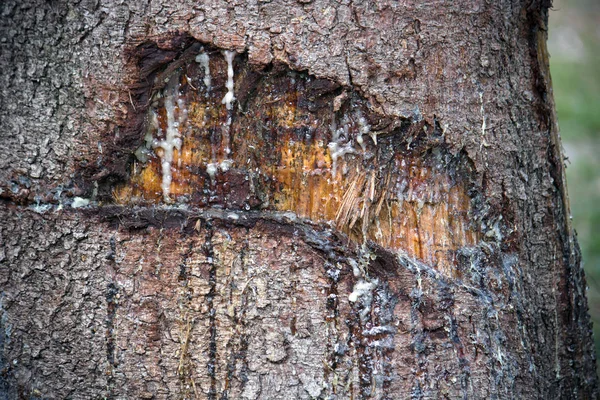November 20, 2023 – Injuries to trees that expose the wood or kill the bark may allow insects or disease organisms to enter the tree. Proper treatment protects the tree and promotes faster healing. Few trees reach maturity without receiving one or more wounds from a variety of sources. Yet trees have survived for centuries to become the oldest living creatures on earth despite wounding. Some recent work has involved dissecting trees in an effort to understand how they compartmentalize and close an injury. Trees do not heal in the true sense of the word. Injured tree tissue is never repaired and returned to the former state as is a cut on a person’s hand. Trees react by closing the wound and compartmentalizing or isolating the injured tissue from the surrounding tissue. During compartmentalization enclosure, contents from the injured cells leak onto the uninjured surface where they oxidize and form a barrier to prevent further infection. Then the most recently laid down wood is altered as is the tissue around the injury. This is accompanied by discoloration, the extent of which depends on the kind of tree, the vigor, kind of wound, location of the wound and the time of wounding. New growth rings are laid down the following spring and new tissue begins to grow over the injured tissue. Over a period of time, the new tissue closes the wound.
Homeowners can help the plant compartmentalize the damage more rapidly than it does in nature. If bark has been crushed or stripped from the trunk, remove the injured bark, shape the wound. Cut away all damaged bark and remove isolated scraps from the wound area. For fastest healing, shape the edge of the wound, as nearly as possible, to an elongated ellipse. If this shape cannot be obtained, shape the top and bottom of the wounded area so they come to a point, even if the wound must be enlarged slightly. Remove all splintered wood and smooth the surface of the exposed area with a chisel.
Some true injuries result in cavities or hollows within the main trunk or large branch of a tree. For many years gardeners have tried to fill these cavities with bricks, concrete and other materials in an effort to seal the cavity from rain, insects and diseases. Armed with the knowledge of the plant’s ability to compartmentalize any wound it is not recommended to fill tree cavities. If water does not drain easily out of the cavity, many arborists will recommend trimming the cavity opening so that water can drain out. If this is not possible, a weep hole may be drilled into the bottom of the cavity to allow water to drain freely. Other than these actions, simply keeping the cavity clean of debris and leaves is all that is recommended.
For a year or more after a tree has been struck by lightning, it is often difficult to determine the extent of damage since much of the injury may be internal. Trees that seem badly damaged may live while others apparently only mildly injured may die. If the tree can be saved, remove all shattered parts and damaged limbs; then smooth and paint exposed wood.
In storm-damaged trees, remove all broken branches and reshape the tree as well as possible at the particular time. Try to encourage new branch development in areas with broken branches. Broken trunks, split crotches or cracked limbs often are mended by restoring the damaged part to its original position and holding it there permanently. Consult professional arborists to install screw rods or cables in trees where this work is necessary. For more information on this or any other agricultural topic please contact the Hopkins County Extension Office at 903-885-3443 or email me at [email protected].






